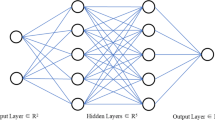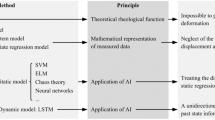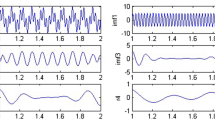Abstract
Rock burst is one of the major disasters that endanger coal safety production. If a rock burst occurs, it will cause terrible casualties and significant property losses. Therefore, this article proposes to predict the sensitive characteristics of microseisms, which can achieve the prediction and early warning of rock burst disasters to a certain extent. To effectively improve the prediction accuracy and robustness of microseismic sensitive feature data, a hybrid model called VMD-Transformer is suggested in this study for predicting time series of microseismic sensitive features. This model is based on the variational mode decomposition (VMD) and transformer model and aims to predict future eigenvalue from the historical data of sensitive features. To a certain extent, the transformer model is used to predict the future eigenvalue, while the VMD is used to extract the features of the time series data at various frequency domain scales, which solves the problem of non-stationary time series data being difficult to predict accurately due to high fluctuations. This study extracts sensitive features from microseismic events that the same source registered by a certain geophone after locating, decomposes the time series of the sensitive features using VMD, predicts each component of the decomposition separately using the transformer model, and then combines the component prediction results to produce the final prediction results. Experimental results indicate that our method has the features of a simple algorithm, strong adaptivity, and high prediction accuracy and can effectively predict time series of sensitive features extracted from microseismic signals.












Similar content being viewed by others
Availability of data and materials
The datasets generated during and analyzed during the current study are available from the corresponding author on reasonable request.
Code Availability
Code to support this study is available from the corresponding author on reasonable request.
References
Al-Chalabi H, Al-Douri YK, Lundberg J (2018) Time series forecasting using ARIMA model: a case study of mining face drilling rig. 12th International Conference on Advanced Engineering Computing and Applications in Sciences (ADVCOMP 2018), Athens, Greece, November 18–22, 2018. International Academy, Research and Industry Association (IARIA), pp 1–3
Chang YS, Chiao HT, Abimannan S et al (2020) An LSTM-based aggregated model for air pollution forecasting. Atmos Pollut Res 11:1451–1463
Chen Y (2014) On technology of electromagnetic radiation monitoring and treatment on rock burst in island working face. China Coal 40(4):56–59
Chen YT, Qin J, Li JG et al (2017) Application of ae technique in coal and gas outburst prediction. Mining Safety and Environmental Protection 44(6):11–16
Dou LM, Li ZL, Zhang M (2016) Study on monitoring and early warning technology of mine pressure bump disaster. Coal Sci Technol 44(7):41–46
Dragomiretskiy K, Zosso D (2013) Variational mode decomposition. IEEE Trans Signal Process 62(3):531–544
Hou W, Bian L-j, HB-b, Qin-ming J (2008) The formation conditions, forecast and prevention of impact pressure in deep mine. Journal of Hebei University of Engineering(Natural Science Edition), 25(2):65–68
Humphrey W, Dalke A, Schulten K (1996) VMD: visual molecular dynamics. J Mol Graph 14(1):33–38
Jiang YD, Pan YS, Jiang FX et al (2014) State of the art review on mechanism and prevention of coal bumps in China. J China Coal Soc 39(2):205–213
Lan H, Qi QX, Pan JF, Peng YW (2011) Analysis on features as well as prevention and control technology of mine strata pressure bumping in China. Coal Sci Technol 39(1):11–15
Li BL (2022) Research on precursory response characteristics of multi-parameter and temporal-spatial fusion early warning of rockburst. PhD thesis, China University of Mining and Technology
Li JP (2000) Application of AE techniques in mining engineering. Industrial Safety and Environmental Protection 1:32–35
Li QL, Lv GC (2007) Study of using AE theory to predict rock burst
Li YL (2020) Exploration and application of microseismic monitoring technology in deep mining. Energy And Energy Conservation
Liu H (2020) Research on comprehensive prediction methodology of rockburst hazard in coal mine based on machine learning. PhD thesis, Shandong University of Science and Technology
Liu ZT, Liu XF, Wang EY (2009) An ARMA prediction model for electromagnetic radiation data preceeding a rock burst. Zhongguo Kuangye Daxue Xuebao, 38
Ma H, Ren MX, Gao K (2022) Prediction model of gas emission amount based on XGBoost optimized with random search algorithm. J Safety Sci Technol 5:18
Nie BS, He XQWE, Linming D (2000) Forecasting rockburst with the electromagnetic emission method in coal mine. J Taiyu An University Technol 31(6):609–611
Ouyang T, Shan K, Zhou BT et al (2021) Research on the online forecasting of algal kinetics based on time-series data and LSTM neural network: taking Three Gorges Reservoir as an example. J Lake Sci 33(4):1031–1042
Pan YS, Luo H, Xiao XC et al (2012) Experimental study on mechanical-charge induction law of coal containing gas under triaxial compression. J China Coal Soc 37(6):918–922
Pan YS, Zhao YF, Li GZ (2012) Charge-induced technique of rockburst prediction and its application. Chin J Rock Mech Eng 31(A02):3988–3993
Shu-lin L (2009) Discussion on microseismic monitoring technology and its applications to underground projects. Chin J Undergr Space Eng, 1
Shumway RH, Stoffer DS (2017) Arima models. With R Examples, Time Series Analysis and Its Applications, pp 75–163
Teng Ji-wen ZX-m, Hui Y (2008)Exploration and exploitation in second deep space of crust interior and high efficient utilization of major energy-coal resource in China. Progress In Geophysics, 4
Tian XH, Li ZL, Song DZ et al (2020) Study on microseismic precursors and early warning methods of rockbursts in a working face. Chin J Rock Mech Eng 39(12):2471–2482
Vaswani A, Shazeer N, Parmar N, et al (2017) Attention is all you need. Adv Neural Inf Process Syst, 30
Wang JQ, Du Y, Wang J (2020) LSTM based long-term energy consumption prediction with periodicity. Energy 197:117–197
Wang YH, Liu LL, Xu YS (2017) Study on predicted method of mine pressure bump based on improved BP neural network. Coal Sci Technol 45(10)
Wang YQ, Ma L, Chen BH (2006) Research and application of drill chip method in monitoring rock burst. Coal Mine Modernization (z1):153–154
Zhang JF, Zhang H, Ding S, et al (2021) Power consumption predicting and anomaly detection based on transformer and k-means. J Mol Graph, 681
Zhang TJ, Song S, Li S et al (2019) Research on gas concentration prediction models based on LSTM multidimensional time series. Energies 12(1):161
Zhang XL, Cao LY, Chen Y et al (2022) Microseismic signal denoising by combining variational mode decomposition with permutation entropy. Appl Geophys 19(1):65–80
Zhao SK, Zhai MH, Qi QX, et al (2019) Part 6: Monitoring method of drilling bits. In Methods for test, monitoring and prevention of rock burst. State Administration for Market Regulation
Zhao XD, Tang CA, Li YH et al (2005) Prediction method of rock burst on microseismic monitoring and stress field analysis. Chin J Rock Mech Eng 24(A01):4745–4749
Zhou CH, Li YA, Yin JM et al (2020) Multivariate early warning method for rockbursts based on comprehensive microseismic and electromagnetic radiation monitoring. Chin J Geotech Eng 42(3):457–466
Funding
The research was supported by the National Natural Science Foundation of China (grant no. 51904173) and the Natural Science Foundation of Shandong Province (grant no.ZR2023ME032 and no. ZR2022ME091).
Author information
Authors and Affiliations
Contributions
XZ: conceptualization, methodology, writing—original draft, investigation, software, validation. DH: conceptualization, validation, writing—review and editing. QM: investigation, writing—review and editing. ZW: software, writing—review and editing.
Corresponding author
Ethics declarations
Competing interests
The authors declare no competing interests.
Additional information
Publisher's Note
Springer Nature remains neutral with regard to jurisdictional claims in published maps and institutional affiliations.
Highlights
\(\bullet \) The proposed VMD-Transformer is more adaptable and accurate in non-stationary time series prediction.
\(\bullet \) The experiments show that the VMD-Transformer has acceptable results on microseismic sensitivity feature data.
\(\bullet \) Predictive studies of microseismic sensitivity features provide theoretical support for rock burst prediction and early warning.
Rights and permissions
Springer Nature or its licensor (e.g. a society or other partner) holds exclusive rights to this article under a publishing agreement with the author(s) or other rightsholder(s); author self-archiving of the accepted manuscript version of this article is solely governed by the terms of such publishing agreement and applicable law.
About this article
Cite this article
Zhang, X., Hou, D., Mao, Q. et al. Predicting microseismic sensitive feature data using variational mode decomposition and transformer. J Seismol 28, 229–250 (2024). https://doi.org/10.1007/s10950-024-10193-9
Received:
Accepted:
Published:
Issue Date:
DOI: https://doi.org/10.1007/s10950-024-10193-9




